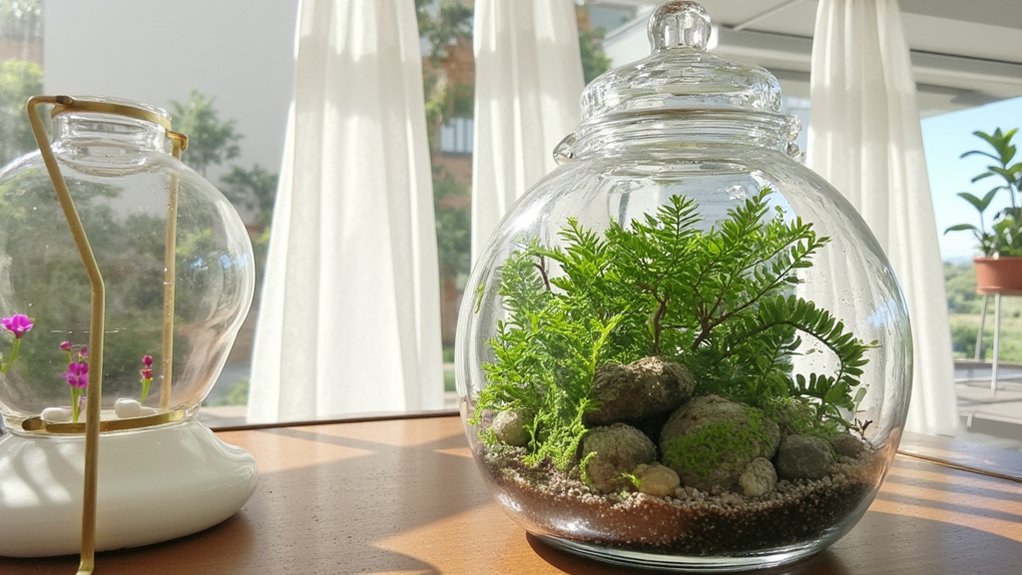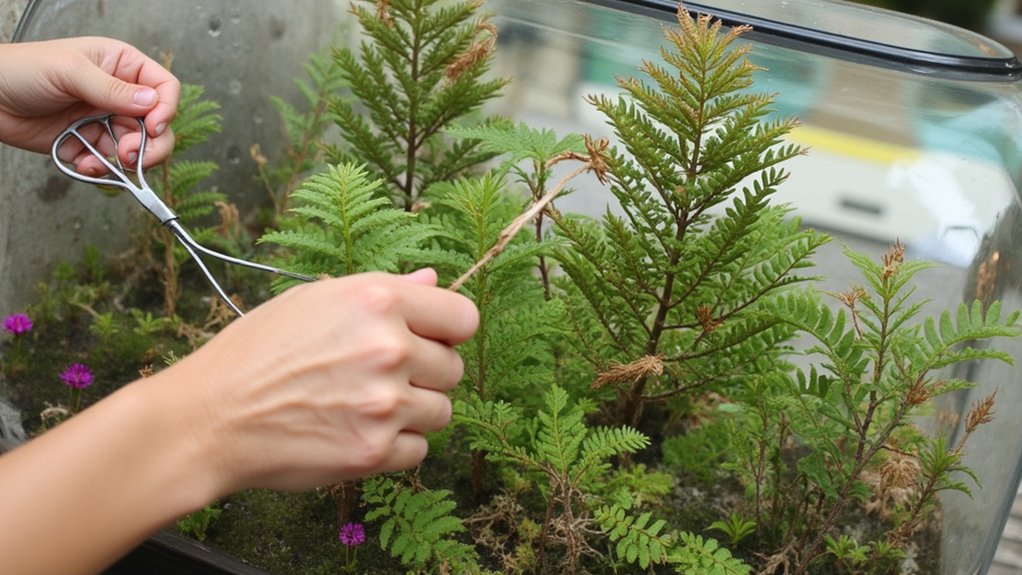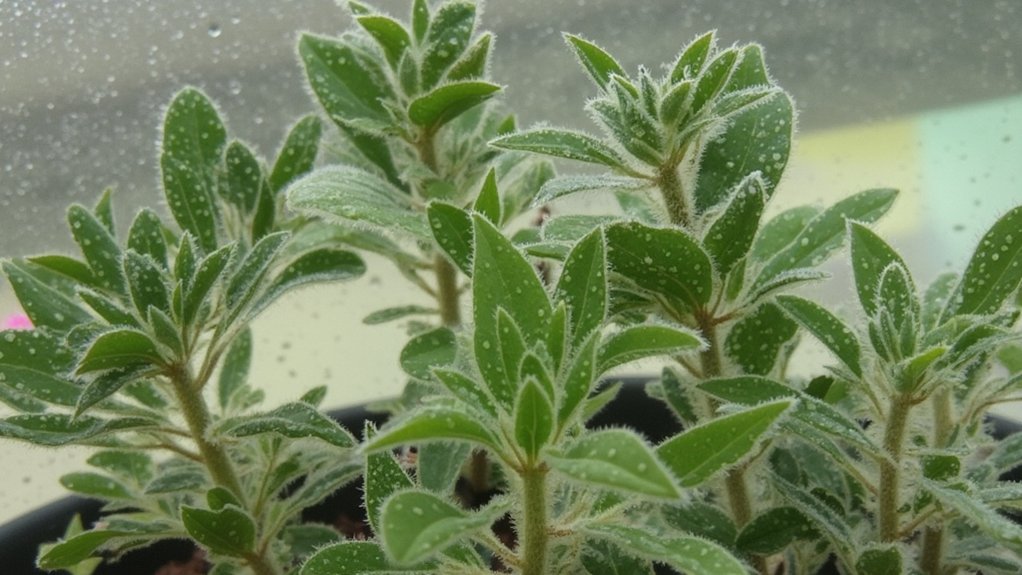Studies show that closed terrariums can sustain plant life for up to 53 years with minimal intervention. You’ll find that creating a thriving enclosed garden ecosystem isn’t just about placing plants in a glass container – it’s a delicate balance of light, moisture, and care. While the concept might seem straightforward, mastering the specifics of placement, watering schedules, and maintenance techniques will determine whether your terrarium flourishes or fails.
Contents
- 1 Choosing the Perfect Location and Lighting
- 2 Monitoring and Adjusting Moisture Levels
- 3 Cleaning and Pruning Your Terrarium Plants
- 4 Managing Temperature and Humidity
- 5 Dealing With Common Plant Health Issues
- 6 Removing Dead Plant Material and Debris
- 7 Fertilizing and Nutrient Management
- 8 Maintaining the Glass Container
Choosing the Perfect Location and Lighting

While a closed terrarium can thrive in various indoor spaces, choosing the right location is essential for your plants’ long-term success. You’ll want to place your terrarium in a spot that receives bright, indirect sunlight, ideally 3-5 feet from a north or east-facing window.
Don’t place your terrarium in direct sunlight, as it’ll create a greenhouse effect and cook your plants. Instead, find a stable surface away from heating vents and air conditioners, maintaining temperatures between 65-80°F. If natural light isn’t sufficient, you can supplement with a LED grow light positioned 12 inches above the container.
Monitoring and Adjusting Moisture Levels
Since closed terrariums create their own mini-ecosystem, monitoring moisture levels is essential for maintaining the delicate balance inside. You’ll know your terrarium has the right moisture when tiny water droplets form on the glass walls during the day, disappearing by evening.
If you notice excessive condensation that obscures your view, remove the lid for 15-20 minutes. Conversely, if there’s no condensation for several days, add 2-3 tablespoons of distilled water using a spray bottle or pipette.
Check your terrarium’s moisture levels every 2-3 days. The soil should feel slightly damp, not wet, when you insert your finger about 1/2 inch deep.
Cleaning and Pruning Your Terrarium Plants

Regular cleaning and pruning help maintain your terrarium’s health beyond just managing moisture levels. Remove any dead leaves, fallen debris, or signs of mold immediately using long tweezers or bamboo sticks to avoid disturbing other plants.
Trim overgrown plants when they touch the glass or crowd other specimens, cutting just above leaf nodes at a 45-degree angle. Don’t let pruned material fall into the soil. For moss maintenance, gently brush away dust with a soft paintbrush once a month.
Clean the interior glass walls quarterly using a microfiber cloth on a stick, being careful not to disturb the soil or damage plant leaves.
Managing Temperature and Humidity
Because closed terrariums create their own microclimate, maintaining proper temperature and humidity levels is essential for plant survival. Keep your terrarium between 65-80°F (18-27°C), and avoid placing it in direct sunlight or near heating vents, which can cause overheating.
You’ll want to maintain humidity levels between 60-80%. If you notice excessive condensation on the glass walls, simply remove the lid for 15-20 minutes. Conversely, if the soil appears dry or humidity drops below 60%, mist the plants lightly with filtered water.
Check the temperature using a small digital thermometer, and monitor humidity with a hygrometer to guarantee ideal growing conditions.
Dealing With Common Plant Health Issues

Even the most carefully monitored terrarium environment can experience plant health issues. If you notice yellowing leaves, trim them immediately with sterilized scissors and check your lighting conditions, as this often indicates too much direct sun. Reduce watering if you spot any fuzzy mold growth.
Brown spots typically signal bacterial or fungal infection. Remove affected areas and apply a diluted neem oil solution (1 teaspoon per cup of water) to the remaining healthy foliage. For pest infestations like mealybugs or spider mites, use cotton swabs dipped in 70% isopropyl alcohol to remove them, then treat with insecticidal soap every 5-7 days until resolved.
Removing Dead Plant Material and Debris
Staying on top of dead plant material keeps your terrarium healthy and visually appealing. Use long tweezers or curved scissors to carefully remove yellowed leaves, fallen stems, and any decaying matter as soon as you spot them. Dead plant material can quickly lead to mold growth and bacterial issues if left unchecked.
When cleaning, don’t forget to remove debris that’s settled on the soil surface, including fallen moss pieces and algae buildup. If you notice a particularly dense area of dead material, gently lift surrounding plants to access it without damaging healthy roots or stems. You’ll want to perform these maintenance checks at least once every two weeks.
Fertilizing and Nutrient Management
While closed terrariums create their own miniature ecosystems, you’ll still need to provide supplemental nutrients every 4-6 months to maintain healthy plant growth.
Use a liquid fertilizer diluted to quarter-strength, applying just 2-3 drops per plant with a clean eyedropper. Choose a balanced formula with an NPK ratio of 10-10-10 or lower to avoid burning delicate roots.
Watch for signs of nutrient deficiency, like yellowing leaves or stunted growth. If you notice excess algae or rapid growth after fertilizing, you’ve likely over-fertilized. Skip the next scheduled feeding and reduce future application amounts by half.
Maintaining the Glass Container
The glass container that houses your terrarium’s miniature ecosystem needs regular maintenance to keep your view crystal clear and your plants thriving. Clean the exterior weekly with a lint-free cloth and glass cleaner, avoiding any liquid seepage into the container.
For interior cleaning, remove condensation buildup using a long-handled sponge or microfiber wand, especially if it blocks your view. If you notice mineral deposits forming, use a mixture of one part white vinegar to four parts distilled water, carefully applying it with a cotton swab. Don’t forget to clean the lid’s underside monthly, where condensation often accumulates.
